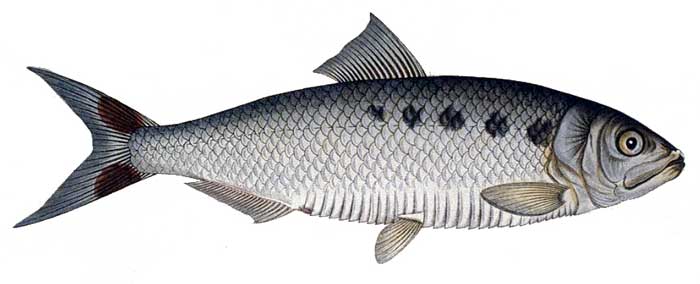
Superregnum : Eukaryota
Regnum: Animalia
Subregnum: Eumetazoa
Cladus: Bilateria
Cladus: Nephrozoa
Superphylum: Deuterostomia
Phylum: Chordata
Cladus: Craniata
Subphylum: Vertebrata
Infraphylum: Gnathostomata
Megaclassis: Osteichthyes
Superclassis/Classis: Actinopterygii
Classis/Subclassis: Actinopteri
Subclassis/Infraclassis: Neopterygii
Infraclassis: Teleostei
Megacohors: Osteoglossocephalai
Supercohors: Clupeocephala
Cohors: Otomorpha
Subcohors: Clupei
Superordo: Clupeomorpha
Ordo: Clupeiformes
Subordo: Clupeoidei
Familia: Clupeidae
Subfamilia: Alosinae
Genus: Alosa
Species: Alosa alosa
Name
Alosa alosa (Linnaeus, 1758)
Original combination: Clupea alosa
References
Hundt, M., Scharbert, A., Weibel, U., Kuhn, G., Metzner, K., Jatteau, P., Pies, A., Schulz, R. & Gergs, R., 2015: First evidence of natural reproduction of the Allis shad Alosa alosa in the River Rhine following re-introduction measures. Journal of Fish Biology, Article first published online: 26 JUN 2015 DOI: 10.1111/jfb.12721
Linnaeus, C. 1758. Systema Naturae per regna tria naturæ, secundum classes, ordines, genera, species, cum characteribus, differentiis, synonymis, locis, Tomus I. Editio decima, reformata. Holmiæ: impensis direct. Laurentii Salvii. i–ii, 1–824 pp DOI: 10.5962/bhl.title.542: 318. Reference page.
Links
Integrated Taxonomic Information System
Swedish Museum of Natural History Ichthyology name database
IUCN: Alosa alosa (Least Concern)
Alosa alosa in the World Register of Marine Species
Vernacular names
brezhoneg: Aloz
català: Alosa alosa
čeština: Placka pomořanská
Deutsch: Maifisch
English: Allis shad
español: Sábalo
euskara: Kolaka
suomi: Pilkkusilli
français: Grande alose
galego: Zamborca
magyar: Fattyúhering
íslenska: Maísíld
lietuvių: Alsė
Nederlands: Elft
norsk nynorsk: Maisild
norsk: Maisild
polski: Aloza
português: Sável
српски / srpski: Alosa alosa
svenska: Majfisk
українська: Пузанок звичайний
Tiếng Việt: Allis Shad
中文: 西鯡
The allis shad (Alosa alosa) is a widespread Northeast Atlantic species of fish in the herring family, Clupeidae. It is an anadromous fish which migrates into fresh water to spawn.[2][3] It is found in the eastern Atlantic Ocean, the western Baltic Sea and the western Mediterranean Sea. In appearance it resembles an Atlantic herring but has a distinctive dark spot behind the gill cover and sometimes a row of up to six spots behind this. It sometimes hybridises with the twait shad (A. fallax). This fish becomes mature when three or more years old and migrates to estuaries, later swimming up rivers to spawn. Populations of this fish have declined due to overfishing, pollution and habitat destruction. Conservation of this species is covered by Appendix III of the Bern Convention and Appendix II and V of the European Community Habitats Directive.
Description
The allis shad is a typical herring-type fish. It has no lateral line and a somewhat rounded belly. The gill cover is ridged and the scales large. The back is a bluish-green colour and the head brownish with a golden tinge on the operculum. The flanks are silvery, sometimes with a bronzy tinge, and a distinctive large dark spot occurs just behind the gill cover, and occasionally one to six smaller spots behind that. The adult length is typically 30 to 60 cm (12 to 24 in).[4][2]
Distribution
The allis shad is found in the eastern Atlantic in waters bordering most of Europe and northwestern Africa, and it enters to the western Baltic and western Mediterranean Seas, but it is rare outside France.[2][1]
Biology and lifecycle
Biology and lifecycle of Alosa alosa.
Alosa alosa has a similar lifecycle to that of the twait shad A. fallax. They are known to live in sympatry,[5] and the two species can hybridize.[6] They are anadromous species like many other species in the genus Alosa.[6] However, some record of them being landlocked suggests an ability to adapt well to their environment.[6] They primarily live at sea on feeding grounds and migrate to their spawning grounds between April and June once they are sexually mature.[6] Maturity usually ranges from 3–7 years of age.[6] A. alosa can usually only reproduce once in their lifetimes.[6] Juveniles appear in estuaries and brackish water around July to August.[5] The salinity of brackish water may pose problems to the juveniles migrating from fresh water.[5]
Population reduction
Populations have been reduced primarily by overfishing, pollution, and habitat destruction.[6] The estuarine phase, or the time that they are in the estuaries migrating from spawning grounds to sea, is estimated to have a duration in A. alosa of up to six months.[5] The estimate, however, does not take into account individual variation and/or survival of juveniles in the estuarine phase.[5]
Conservation
Four special areas of conservation have been designated in Ireland where Alosa species have been known to spawn.[6] Alosa alosa "has been placed in Appendix III of the Bern Convention (1979) that lists protected fauna species as well as in Appendix II and V of the European Community Habitats Directive (1992) that list, respectively, species whose conservation requires the designation of special areas of conservation and that are subject to management measures."[5] However, A. alosa is currently under a moratorium (2008) in numerous French watersheds.[5]
References
Freyhof, J.; Kottelat, M. (2008). "Alosa alosa". IUCN Red List of Threatened Species. 2008: e.T903A13091343. doi:10.2305/IUCN.UK.2008.RLTS.T903A13091343.en. Retrieved 15 November 2021.
Froese, Rainer; Pauly, Daniel (eds.) (2015). "Alosa alosa" in FishBase. April 2015 version.
Freyhof, J.; Kottelat, M. (2008). "Alosa alosa". IUCN Red List of Threatened Species. 2008: e.T903A13091343. doi:10.2305/IUCN.UK.2008.RLTS.T903A13091343.en. Retrieved 18 November 2021.
"Allis shad: Alosa alosa". NatureGate. Retrieved 14 December 2013.
Lochet, A., S. Boutry, and E. Rochard. Estuarine Phase during Seaward Migration for Allis Shad Alosa Alosa and Twaite Shad Alosa Fallax Future Spawners. Ecology of Freshwater Fish 18 (2009): 323-35.
Coscia, I., V. Rountree, J. J. King, W. K. Roche, and S. Mariani. A Highly Permeable Species Boundary between Two Anadromous Fishes. Journal of Fish Biology doi:10.1111/j.1095-8649.2010.02768.x 77.5 (2010): 1137-149.
Retrieved from "http://en.wikipedia.org/"
All text is available under the terms of the GNU Free Documentation License


